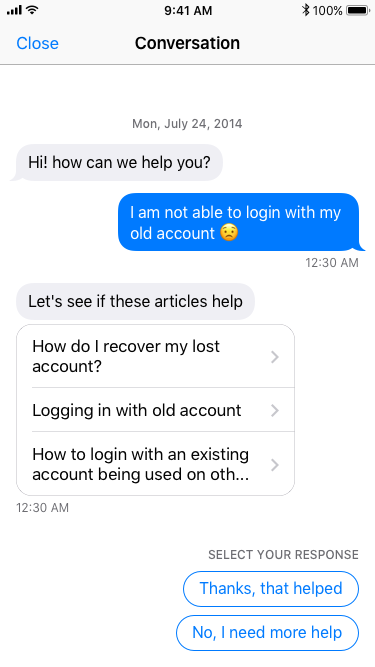
A decade ago, a timely response to a customer complaint could differentiate a company in a crowded marketplace. Thanks to digital technology, however, customer service expectations are bulging by the minute.
According to a study by Gladly, 71% of customers expect customer service to be consistent across channels. Another study by Salesforce found that 72% of business buyers expect companies to personalize their communication.
Bottom line: It’s not just about speed anymore.
So, how do you respond to these rising customer service expectations?
Doubling your budget will certainly help but, first, you can try to optimize some of your processes. Let us walk you through four customer service workflows that you can automate to save time, while also delighting your customers.
Allow customers to serve themselves
We can’t underestimate the value of real agents helping the customer, but this doesn’t rule out automating customer support by allowing customers to help themselves. On the contrary, a 2015 Aspect Customer Experience Surveyfound that 73% of customers want the ability to search for solutions themselves, and some even prefer it to talk to a company rep.
Self-service is one of these rare solutions that benefit everyone involved. On one hand, customers are satisfied because they can find information instantly without having to wait for an agent to respond. On the other hand, your support team’s load is reduced because the most frequent queries are resolved without their effort.
So, how do you automate your self-service workflow?
One of the ways to automatically deflect common queries is to use a chatbot tooltogether with a knowledge base tool. When a customer types a question in the live chat, the bot steps in, pulls information from your knowledge base software, and tries to answer. If it fails, the ticket is automatically assigned to an agent.

To take self-service automation a step further, look at the statistics from your chatbot and your knowledge base. Search queries from your knowledge base can help you optimize the chatbot scripts. Chat logs can help you decide what articles to create for your knowledge base.
Collect customer feedback
Simple customer satisfaction surveys and feedback forms such as NPS and CSAT help you keep a finger on the pulse of your customer base. Both NPS and CSAT won’t take more than a few minutes to set up with the right form automation software but the data that you will receive is invaluable.
An NPS survey starts with the question “How likely are you to recommend our company?” or a variation of it. The customer can rate their answer on a scale from 0 to 10. In the end, an NPS score between -100 and 100 is calculated. This type of survey helps you pinpoint general improvements in your product or service.
A CSAT survey is just as straightforward. Customers evaluate the product or service on a 1-5 rating scale. As an example:
- Very unsatisfied
- Unsatisfied
- Neutral
- Satisfied
- Very satisfied

An overall customer satisfaction score can then be calculated using this formula

CSAT can help you gauge customer satisfaction on any level. However, when evaluating your CSAT results, keep in mind that a higher score does not necessarily translate to repeat customers, but a low score usually signals to churn.
Let’s see how you can automate customer feedback surveys.
First, you have to decide what you want to know and trigger the survey at the right moment. Let’s suppose you want to measure individual agent performance. In this case, you can send a survey each time a customer interacts with a different agent. By contrast, if you want to understand your team’s overall effectiveness, you can trigger a survey after a ticket has been resolved.
If your feedback collection tool has integrations with other systems,you can use your survey results to perform other tasks such as segmenting customers in your CRM. Or you can make use of call center software togive your customers a more personal way of providing feedback and discussing problems.
Optimize employee onboarding
According to UpWork, it takes six months for customer support reps to become proficient in their work. It’s understandable. There has to be a “shadowing” period where the new hire observes experienced agents as they handle customer requests. However, part of the employee onboarding process can be automated to save your team time and resources.
Here are a couple of ways you can do this.
Creating an internal knowledge baseThis empowers new agents to find the information they need instantly so they can be more efficient. Your internal KB can feature articles with:
- General Product or service knowledge
- Support workflow and policies
- Customer service best practices
- Technical information

Set up dummy ticketsInstead of having an experienced employee sit side-by-side with the new hire, you can create a set of simulated tickets that cover a wide range of common support issues. This way, the new rep can get used to your ticketing system while also practicing how to respond to customers. When the test is done, a more experienced employee or a manager can review the responses.
Make use of surveys. After a new customer support team member has gone through the onboarding process, you’ll want to get an idea of how effective the actual onboarding process is.
This is where employee feedback and satisfaction surveys come into play.

Employee feedback surveys can give you important information that allows you to track each employee’s progress to gauge how much training content they are consuming, how well they understand the materials, and how effective the overall program is.
To automate this process, you can send a survey when a new hire completes a particular orientation milestone as well as after they complete the new onboarding process.
Automate triage + ticketing routing
Managing your help desk ticketing system can take up a large portion of your team’s time. Worse yet, tickets can often bounce between departments until they reach the right person. The end result is increased response time and unhappy customers.
The good news is that ticket triage and routing doesn’t have to be all tedious manual work.
You can ‘outsource’ it to your help desk software—most such systems allow you to specify automation rules to sort incoming requests on the fly.

Let’s look at some of the ways you can use these rules.
- PrioritizeImagine you have an enterprise customer ABC Inc that requires an instant response. You can create a rule to assign the highest priority to all tickets that come from email accounts ending in @abc.com.
- Route tickets based on categories. Let your customers choose the category their request falls in. Then, create a rule to auto-assign each ticket category to the corresponding support team.
- Prevent slow response, e.g. When a ticket hasn’t been updated for 8 hours and has priority “Critical”, send an email to the administrator.
- Send a customer survey, e.g. When the ticket is closed automatically, send a survey to gauge customer satisfaction.
- Auto-close tickets, e.g. When a customer hasn’t replied in X days, close the ticket.
Final remarks
Customer service expectations are rising every day. To be able to respond and compete in today’s crowded marketplace, companies have to optimize their support workflows. This doesn’t have to involve a larger budget but, rather, making use of automation.
There are a number of tasks your support team can streamline with the help of modern technology. For example, to speed up self-service, you can use a chatbot together with a knowledge base; to improve agent onboarding, you can create dummy tickets; and so on. Examine your current support workflows closely and you will find many opportunities for automation.



 5 min read
5 min read

